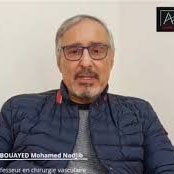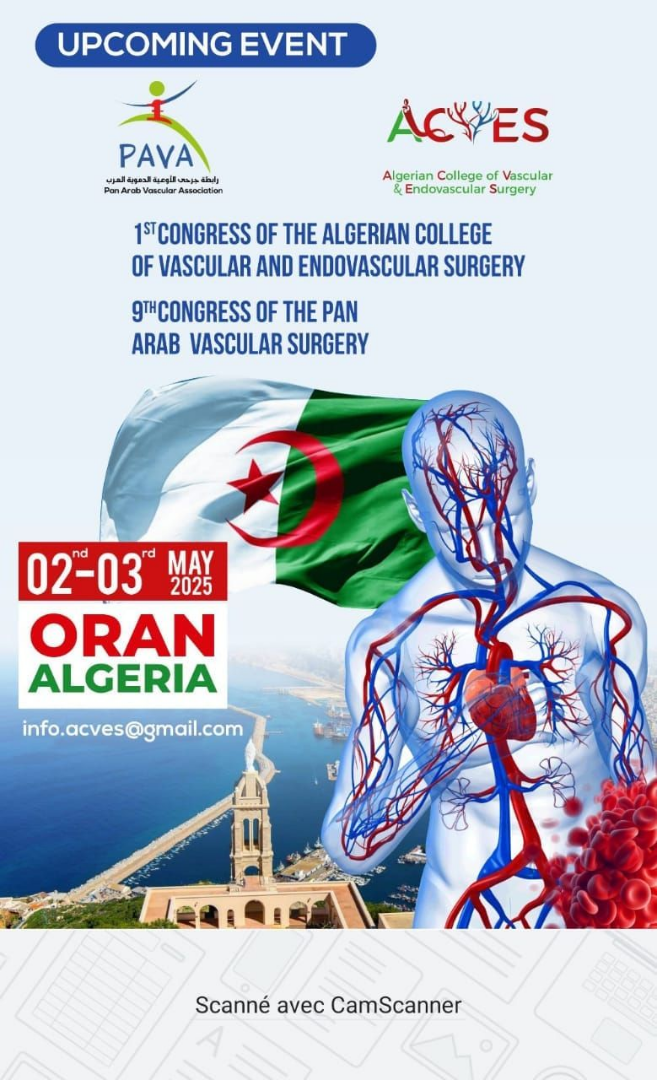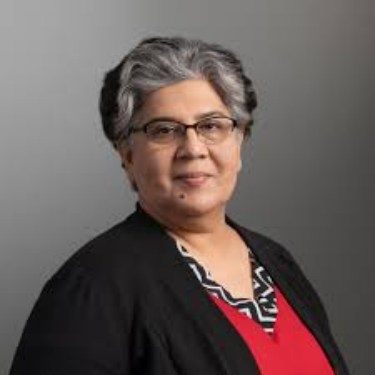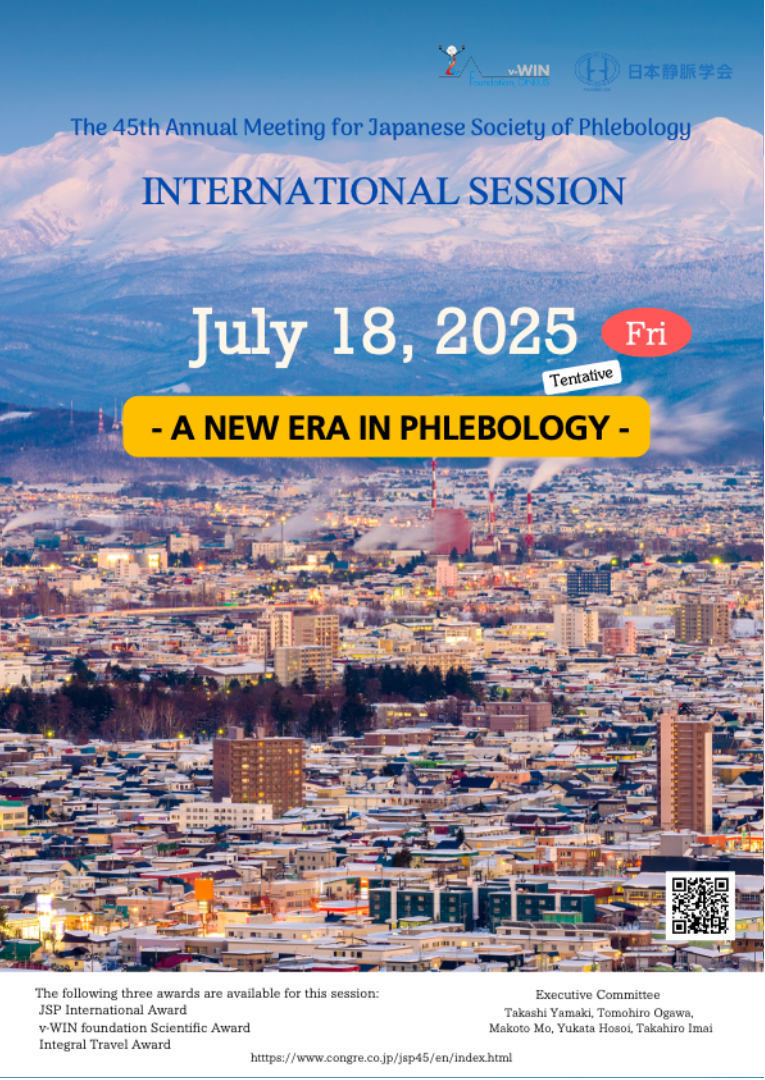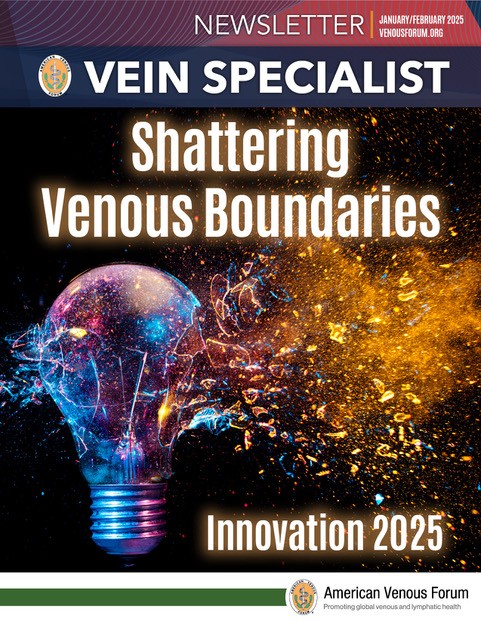
AVF’s Expertise during the Upcoming Meeting
of the Algerian College of Vascular and Endovascular Surgery
We are extremely excited to announce the convening of the Vascular and Endovascular Surgery Congress taking place in the beautiful city of Oran, Algeria, on May 2-3, 2025. This meeting is organized by the national society, the Algerian College of Vascular and Endovascular Surgery (ACVES) with the collaboration of the Pan Arab Vascular Association (PAVA).This event promises to bring together world-renowned experts and groundbreaking innovations in vascular health.
Our goal is to offer global expertise, interactive learning, and networking opportunities including connections with researchers and industry experts from around the world.
We hope that this prestigious meeting will unite leading experts, share cutting-edge research, and describe the latest advances in vascular medicine and surgery in diagnostics, treatments, and surgical techniques.
Attendees will have access to expert insights to gain knowledge from top specialists in vascular surgery, angiology, venous and lymphatic medicine, including coverage of current innovations.Whether you are a surgeon, physician, researcher, or healthcare professional, this congress will inspire and empower you to advance in your practice.
The congress will focus on groundbreaking developments in:
- Venous Medicine:Innovative approaches to chronic venous disease, varicose veins, deep vein thrombosis, and advanced endovenous treatments.
- Lymphatic Disorders:Cutting-edge therapies and surgical advances for lymphedema, including regenerative medicine, lymphatic imaging, and patient-centered care.
- Aortic disorders
- Carotid diseases
- Diabetic foot(endovascular and open surgery treatments)
To give more value to our congress, we are proud to have strong participation of the prestigious American Venous Forum (AVF), a leading global medical authority and one of the world’s most respected organizations in venous and lymphatic medicine. We will have the opportunity to share the expertise of internationally renowned AVF members as they lead interactive discussions and workshops on key issues in vascular health. We are looking forward to a close collaboration with the AVF, especially in research in the areas of venous and lymphatic diseases.
This congress is an unmissable opportunity for surgeons, physicians, researchers, and all healthcare professionals passionate about vascular health to expand their knowledge and enhance their practice. Be part of this transformative event in vascular surgery and angiology!
Standout Wound Care Articles
1.Hu Z, Wang S, Yang H, et al. Efficacy and safety of platelet-rich plasma in the treatment of venous ulcers: A systematic review and meta-analysis of randomized controlled trials. International Wound Journal. 2024; 21(2): e14736
This study evaluated the efficacy and safety of platelet rich plasma (PRP) in venous ulcers.
PRP derived from concentrated whole blood typically boasts a platelet concentration 4 times that of the original sample. It is rich in growth factors such as platelet-derived growth factor, vascular endothelial growth factor, and epidermal growth factor, which play pivotal roles in cellular migration, angiogenesis, proliferation, and differentiation.
A systematic review of 4 data bases identified 16 RCTs that were included in the meta-analysis.
The study compared PRP with conventional treatments for venous ulcers, evaluations, multiple efficacy, and safety outcomes.
Results indicated that PRP significantly improves complete closure rates and healed ulcer sizes, shortens time for complete healing, and reduced recurrence rates without increasing adverse events.
In summary, PRP proved to be an effective method to promote healing of venous ulcers without increasing the incidence of adverse events as compared to traditional therapies, affirming its efficacy and safety.
- Qiu YJ, Osadnik CR, Brusco NK, et a l. Association between physical activity levels and healing in people with venous leg ulcers: secondary analysis of prospective cohort data.Frontiers in Medicine. 2023; 21:10: 1305594
The aim of the study was to explore the relationship between physical activity levels and healing and recurrence in venous leg ulcers. This is a secondary analysis of data from a prospective observational multicenter cohort study. The observational cohort study was related to the ASPirin in VLU (ASPiVLU) randomized control trial. Self-reported questionnaires were used to collect data from participants at baseline visit and at 12- and 24 weeks following the initial screening visit. Participants were classified into 4 distinct groups based on physical activity levels reported at baseline and week 12. Participants were asked to choose one of the 7 statements indicating sedentary, light physical activity level, or moderate-to-vigorous physical activity level. The other measures collected at baseline, week 12, and 24 were proportion of target ulcer healed, time to healing of target ulcer, changes in the target ulcer size, recurrence of target ulcer, health- related quality of life, and wound pain score.
The survival analysis showed that higher physical activity level was associated with a shorter time to healing. The persistently moderate-to-vigorous group had a 7.3-fold increased likelihood of healing compared to the persistently sedentary group. High levels of physical activity were also associated with a better quality of life score at baseline, week 12, and week 24. Most participants (48.5%) reported low levels of physical activity, which remained low for the entire study period.
The authors concluded that an increased level of physical activity was linked to a shorter healing time and enhanced quality of life. Low levels of physical activity appeared common among people with venous leg ulcers.
What is the Risk of VTE in Lymphedema and Lipedema Patients
Is the risk for VTE in lymphedema and lipedema patients the same in patients with obesity as those at normal weight? Is it increased, or is obesity protective?
Khalid et al sought answers by querying the Nationwide Inpatient Sample (NIS), an all-payer, administrative claims-based database containing discharge information in nonfederal US hospitals. They looked at obese female patients (BMI>30) and the presence or absence of VTE and its predictors. (1)
Notable findings include the following (from the article):
Lymphedema was observed in 1.6% (n = 189,985) of the population with a higher prevalence of congestive heart failure (3.2% vs 1.2%; p < 0.01), hypertension (79.7% vs 62%; p < 0.01), chronic kidney disease (CKD) (37.9% vs 30.6%; p < 0.01), dyslipidemia (40.7% vs 37%; p < 0.01), and hypothyroidism (27.5% vs 18%; p < 0.01). CKD occurred twice as frequently in patients with lymphedema with obesity (30.8% vs 17.1%; p < 0.01).
Lipedema was diagnosed in 0.4% (n = 50,645) of the patient population. CKD (20.29% vs 17.32%; p < 0.01), cancer (67.4% vs 68.5%; p = 0.02), hypothyroidism (23.3% vs 19%; p < 0.01), and rheumatoid disease (35.5% vs 36.7%; p = 0.02) were more common in patients with lipedema.
VTE was observed in 3.12% (n = 374,210) of patients with obesity. Patients with VTE had a higher prevalence of CKD, CHF, cancer, metastatic disease, and hypertension compared with obese patients without VTE.
Lymphedema was nearly twice as prevalent in patients with VTE (2.6% vs 1.6%; p < 0.01). Lipedema was observed in 0.6% of the patients with VTE compared to 0.4% in patients without VTE (p < 0.01).
VTE events in obese patients with lymphedema were 1.5-fold higher than in patients without lymphedema (OR 1.5; CI 1.4–1.6; p < 0.01). Lipedema also had greater odds of VTE events (OR 1.2; CI 1.1–1.3; p < 0.01).
Thus, the authors conclude that VTE remains prevalent in patients with lymphedema and lipedema even after adjusting for baseline characteristics, including obesity, suggesting that lymphedema and lipedema constitute a residual risk for VTE adjusting for obesity.
Reference:
Khalid MU et al. Vasc Med. 2024 Feb;29(1):42-47
New AVF Members
| Name & Crendentials | Country |
|---|---|
| Shelly Keller, APRN, CNP | United States |
| Ali Eldeeb, MBBS | Egypt |
| Leslie McGrath, BSN, MS | United States |
| Ursula Barghouth, DO, MHA, MSPH | United States |
| Wojciech Mikusek, MD | Poland |
| Jose Luis Gutierrez Ferreira, DR | Mexico |
| Reethika Ramalingam, MBBS | India |
| Hesham Mohamed Fathalla Rozza, MD | Egypt |
| Mohamed AlMoslemany, MBChB | Egypt |
| Harris Amir, MD | United Kingdom |
| Swapna Anandan, MD | United States |
| Christian Baraldi, MD | Italy |
| Ryan Bird, MD | Canada |
| Carlos Duran, MD | Venezuela |
| Paul Espinoza, MD | United States |
| Takuya Kawahara, MD | Japan |
| Neil Khilnani, MD | United States |
| Anuj Mahajan, MD | United States |
| Evan Merle, MD | United States |
| Anna Ohlsson, MD | United States |
| Chris Reisenauer, MD | United States |
| Yama Sadozai, MD | United States |
| Lili Sadri, MD | United States |
| Mitsumi Yamashita, MD | Japan |
| Timothy Straight, MD, PhD | United States |
| Louis Nguyen, MD, MBA, MPH | United States |
| Wael Shaalan, MD, PhD | Egypt |
| Fabien Thaveau, MD, PhD | France |
| Jacek Waligora, MD, PhD | Poland |
| Atul Laddu, MD, PHD, FACC | United States |
| Pablo Martinez, MD, RVT, RPVI | United States |
| Aman Sinha, MPH | United States |
| Clare Harris, NP | United States |
| Ahmed Hassanin Negila, PA | France |
| Jessica Ochs, PA | United States |
| Lauren Curtis, PA-C | United States |
| Jodi Hirsch, PA-C | United States |
| Megan Verce, PA-C | United States |
| Souad Benallal, PhD | Algeria |
| Yunis Hasanov, PhD | Azerbaijan |
| Joanna Borecka-Sobczak, PhD, MD | Poland |
| Yasser Elkiran, Prof., MD, PhD | Egypt |
| Margareta Lundell, RN | Sweden |

